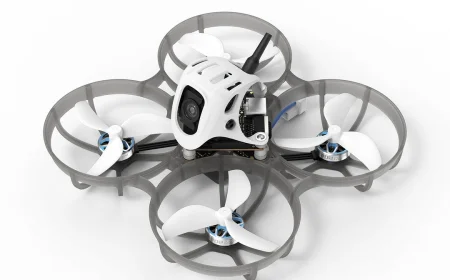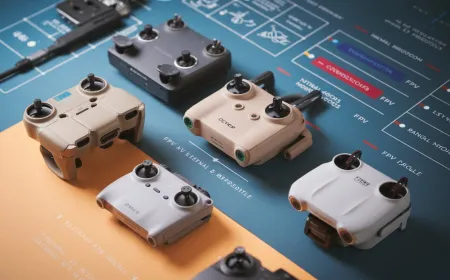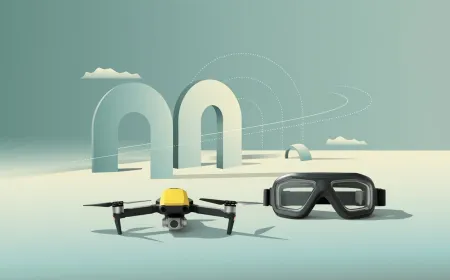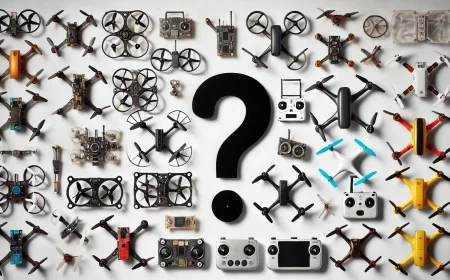FPV Drone for Beginners: How to Choose Your First TinyWhoop Drone
How to choose your first FPV drone for a beginner? Find out which TinyWhoop (65 mm, 75 mm, 85 mm) is suitable for home, outdoors, and FPV racing. Review of Meteor65 Pro, Mobula6, Air65, and components.

Are you interested in FPV drones and want to capture smooth and high-quality video? Or perhaps you dream of flying through abandoned buildings, performing crazy tricks? Or are you attracted to FPV racing?
Whatever your choice, you'll first have to deal with constant crashes and drone accidents. This will happen again and again until you eventually start feeling more confident. If you train in a simulator at the same time, learning will go much faster.
Does drone size matter?
In this article, we'll take a detailed look at which drone a beginner should choose at the start of their FPV journey. Over time, your skills will improve, but you need to start somewhere. And the best option to start with is a TinyWhoop.
TinyWhoop has protective ducts that help avoid damage during falls and collisions with obstacles. They also protect people and animals nearby, as propellers and motors have minimal direct contact thanks to this design. The drone doesn't contain unnecessary external sensors or parts that can break off during crashes. Plus, it's not difficult to repair and doesn't differ much from repairing larger drones, and can be gradually upgraded. And the components themselves will be either similar in price or cheaper than those of larger counterparts.
So, we've determined the type of drone. Now let's consider its size, because even among TinyWhoops there are options — 65 mm, 75 mm, and 85 mm. Manufacturers may label them differently, but this is the general classification.
TinyWhoop 65 mm — the best option for flying in a small house or apartment. Thanks to its compact size, this drone easily flies between shelves, under chairs, tables, and other household obstacles. But in open space, it's only suitable for windless weather, as even light gusts of wind can blow it away, making flights less comfortable.
TinyWhoop 75 mm — a more versatile option. If you have a large apartment or house, such a drone can still be used indoors, although flying through narrow spaces will be more difficult. It's more powerful than the 65 mm and requires better control. In the yard, it feels more confident and is less sensitive to light gusts of wind, although in strong wind, flights will still become less comfortable. Thus, 75 mm is the golden middle between indoor and outdoor flights.
TinyWhoop 85 mm — this size is more suitable for hangars, large spacious houses, or outdoor flights. If you could easily fly through narrow gaps with a 65-mm drone, doing this with an 85-mm will be almost impossible. However, in open space, it demonstrates excellent stability and wind resistance. If you have a large yard, such a drone will be a great choice.
Cost of TinyWhoop configuration
Since the price of drones of different sizes is usually the same or differs minimally, we'll skip this aspect and go straight to analyzing the configuration.
Batteries for TinyWhoop
Let's consider which drone size will cost a beginner less, as getting into FPV is not cheap.
Let's start with batteries. For 65-mm drones, batteries cost less since their capacity is smaller — on average 1S 250-300 mAh. This allows you to buy them in larger quantities.
For 75-mm drones, batteries are on average 20-30% more expensive compared to 65-mm, as they need greater capacity, usually 1S 400-500 mAh.
For 85-mm drones, batteries are at least twice as large as 65-mm ones, since the capacity is about 500 mAh, but they consist of two elements (2S), which also affects the price.
Frames, canopies, and propellers
Frames, canopies, and propellers are consumables, as during flights your drone will inevitably crash into obstacles and fall. Therefore, these components will need to be periodically updated.
The difference in the cost of consumables between drones of sizes 65, 75, and 85 mm is not significant, but the smallest components (for 65 mm) usually cost less.
Battery chargers
If standard 1S batteries are used for drones of sizes 65 and 75 mm, then the chargers for them are the simplest and cheapest or at least the same cost, but not more expensive. Their price depends on the manufacturer and functionality.
When choosing a charger, it's worth paying attention to such features:
- Storage charge mode for batteries
- Ability to charge multiple batteries simultaneously
- Power sources that the device works with
- Presence of indicators for convenience
For 85-mm drones that use 2S batteries, chargers are more complex as they need to balance two elements. Accordingly, their cost is also higher.
Sometimes the cost of chargers is often the same. But it all depends on the region where FPV peripherals are sold.
Conclusion: the cheapest configuration for a beginner
To summarize, the cheapest drones to use for a beginner will be (from cheapest to most expensive):
- 1. Drones on a 65-mm frame
- 2. Drones on a 75-mm frame
- 3. Drones on an 85-mm frame
In the end, you won't feel a strong difference. After buying a complete flight kit, your further expenses will only be on consumables. Expenses may be higher if you want a better flight configuration for FPV if what you have no longer satisfies you.
Choosing a drone for a beginner
I recommend starting with a drone on a 65-mm frame, as it is ideal for training at home. In addition, in good windless weather, you will be able to fly comfortably in the yard as well.
Another important factor is financial benefit. As we've already found out, drones on a 65-mm frame are the cheapest both in terms of the cost of the drone itself and consumables. Therefore, this is the size we will consider first and foremost.
However, if you need a larger drone, you can choose a model on a different frame — nothing limits your choice.
For example, you read this article, watched several videos, and decided that you like the Meteor 65 PRO or Mobula6, but want something a bit bigger. In that case, boldly choose their "big brothers" — Meteor75 PRO, Mobula7, or Mobula8, depending on your needs.
Next, we'll consider only current models that are the best option today.
Meteor65 Pro: a productive micro-drone
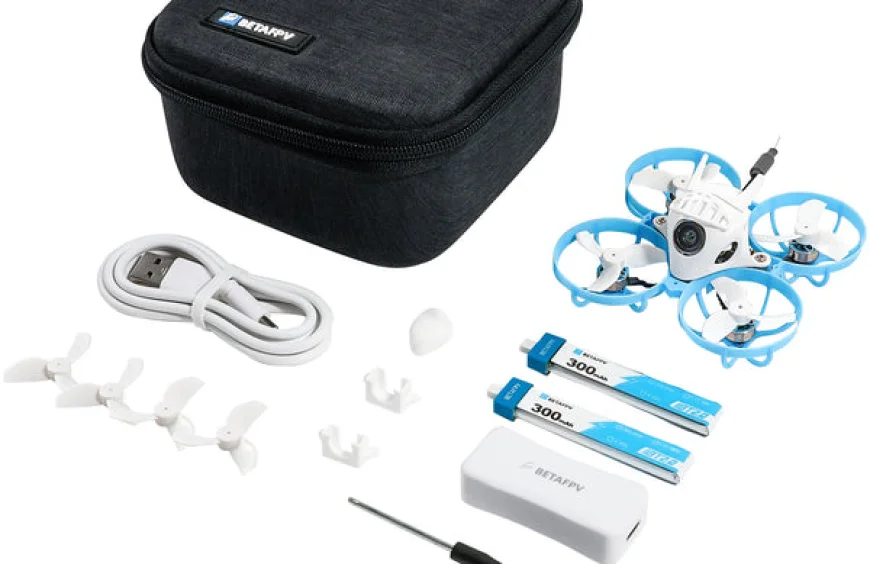
Meteor65 Pro is a high-performance micro-drone that combines lightweight construction with powerful components, providing excellent flight characteristics.
Meteor65 Pro package contents
- Meteor65 Pro quadcopter
- 2 BT2.0 300mAh 1S 75C batteries
- BT2.0 charger and voltage tester
- USB Type-C cable
- Transport case
- Spare 35 mm propellers, 3-blade (1.0 mm shaft)
- Screwdriver
- 3 decorative parts
- Camera mount with 20° tilt angle (for C03 camera)
- Camera mount with 30° tilt angle (for C02 camera)
- Set of screws
Main characteristics of Meteor65 Pro
Motors and propellers
Meteor65 Pro is equipped with 0802SE 19500KV brushless motors combined with 35-mm 3-blade propellers. This provides high maneuverability and flight speed, making the drone ideal for indoor flights.
FPV camera
The drone is equipped with an ultra-light C03 FPV camera (weight — 1.45 g) with:
- Resolution: 1200TVL
- Sensor: 1/3-inch CMOS
- Lens: 2.1 mm
- Field of view: 160°
This provides a clear picture with minimal delay, which is important for FPV flights.
Video transmitter (VTX)
The installed M03 VTX transmitter supports power up to 350 mW, providing a stable signal even in difficult conditions.
Flight controller and receiver
Meteor65 Pro is equipped with F4 1S 5A FC (2022) with built-in receiver:
- ExpressLRS 2.4G
- FrSky
- TBS RX
This guarantees fast and accurate control, which is important for FPV drones.
OSD (on-screen display)
The integrated Betaflight OSD system allows you to adjust flight parameters and track them in real-time.
Flight time
With a BT2.0 300mAh 1S 75C battery, the manufacturer claims up to 4.5 minutes of flight, which is an excellent indicator for micro-drones of this class.
Frame
Meteor65 Pro has a lightweight 65-mm frame made using injection molding technology. It features:
- Low profile
- Low weight (1.6 g)
- High damage resistance
Power connector
The drone uses BT2.0, which provides stable current supply and minimizes voltage sags during flights.
Drone weight
23.01 g (without battery).
Conclusion: why choose Meteor65 Pro?
Meteor65 Pro is a great choice for both experienced pilots and beginners looking for a powerful micro-drone for indoor FPV flights.
Advantages:
- ✔ High-performance components
- ✔ Light and durable construction
- ✔ Stable video signal (VTX 350 mW)
- ✔ Long flight time (up to 4.5 min)
- ✔ Precise control thanks to ExpressLRS, FrSky, or TBS
Thanks to the combination of quality, performance, and thoughtful design, Meteor65 Pro is one of the best micro-drones in its class.
Happymodel Mobula6 2024 ELRS 2.4G
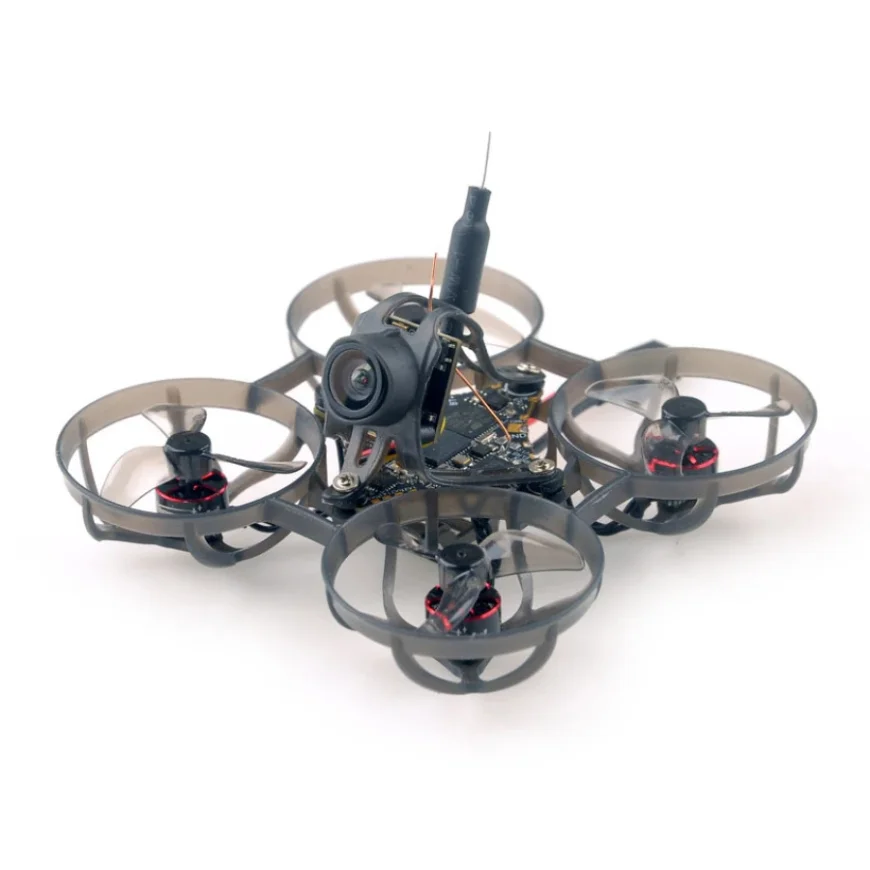
Happymodel Mobula6 is an ultra-light micro-drone specifically designed for indoor flights. Thanks to its compact size and high performance, it's suitable for both beginners and experienced pilots who want to improve their skills in confined spaces.
Package contents
- Mobula6 quadcopter
- Screwdriver
- Spare propellers
- Spare canopy
- Propeller removal tool (facilitates maintenance and replacement without risk of component damage)
Technical specifications
Flight controller
Mobula6 is equipped with a SuperX V02 ELRS AOI FC controller with:
- ✔ Built-in ELRS serial receiver
- ✔ ESC 5A Bluejay
- ✔ Built-in video transmitter (VTX)
This provides stable and clear control over the drone during flight.
Motors
The drone is equipped with SE0702 28000KV motors, which provide high thrust and speed necessary for dynamic maneuvers indoors.
Propellers
3-blade Gemfan 1219-3 propellers (31 mm) are used, optimized for maximum efficiency with the installed motors.
FPV camera
Mobula6 is equipped with an FX17-B camera with:
- Resolution: 800TVL
- Sensor: 1/3" CMOS
- Field of view: 150°
- Signal system: NTSC
- Video aspect ratio 4:3
This provides a clear FPV image with minimal delay, which is critically important for precise control.
Video transmitter (VTX)
The built-in 5.8G VTX supports adjustable power from 25 mW to 400 mW and 40 channels, providing a reliable signal even in difficult conditions.
Frame
- ✔ Light and durable 1S 65 mm Whoop construction
- ✔ Plastic frame with stiffening ribs
- ✔ Minimalist and lightweight canopy
This guarantees resistance to damage, which is important for indoor flights.
Dimensions and weight
Diagonal between motors: 65 mm
Weight: 17.7 g (without battery)
OSD (on-screen display)
Integrated Betaflight OSD for monitoring flight parameters
Power connector
PH 2.0
Flight time
~ 3 minutes on one 1S 300mAh battery
Conclusion: why choose Mobula6?
Happymodel Mobula6 is an ideal micro-drone for indoor FPV flights, combining lightweight construction, powerful motors, and a quality FPV camera.
Main advantages:
- ✔ Ultra-light weight and compact size
- ✔ Powerful SE0702 28000KV motors for quick response
- ✔ Clear FPV picture with minimal delay
- ✔ Stable video signal (VTX up to 400 mW)
- ✔ Reliable construction and resistance to damage
This drone allows you to hone your skills and enjoy dynamic maneuvers, even in a small room.
Review of AIR65 – ultra-light FPV drone for beginners
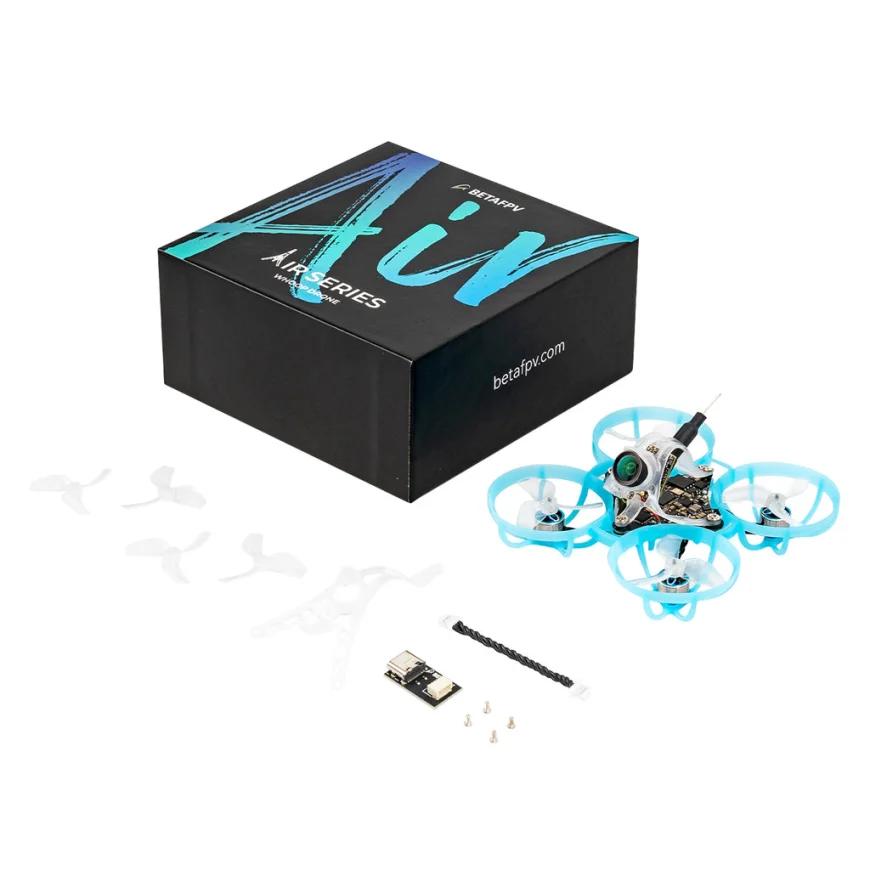
AIR65 is a new product of 2024, which has become a great choice for beginners in FPV due to its lightness and maneuverability. The manufacturer claims that this is the lightest drone in its category, and it is presented in two versions:
- Racing – created for maximum speed and passing tracks with obstacles.
- Freestyle – designed for smooth or aggressive flights with tricks.
The only difference between these versions is the KV of the motors and the type of propellers. Let's take a closer look at them.
Package contents
- AIR65 (brushless quadcopter)
- Spare canopy
- Spare propellers - in Racing version: GF 1219S 3B, and in Freestyle version: HQ 31 mm Ultralight 3B
- 1 × Spare set of screws
- 1 × 4-pin adapter cable
- 1 × USB Type-C adapter board
Technical specifications
Flight controller
Starting from January 3, 2025, AIR65 is equipped with Air Brushless Flight Controller (5-in-1), which includes:
- ✔ FC (flight controller)
- ✔ ESC (electronic speed controller)
- ✔ OSD (on-screen display)
- ✔ VTX (video transmitter)
- ✔ RX (radio receiver)
The controller is based on a powerful G473 processor, ensuring excellent maneuverability and control precision.
Motors and propellers
Freestyle version: 0702SE II 23000KV motors + HQ 31 mm 3B propellers
Racing version: 0702SE II 27000KV motors + GF 1219S 3B propellers
These options are optimized for the corresponding flight style – the freestyle version has a softer response, and the racing one has faster dynamics.
FPV camera
The drone is equipped with a C03 camera with:
- Resolution: 1200TVL
- Sensor: 1/3" CMOS
- Lens: 2.1 mm (field of view 160°)
- Adjustable tilt angle: from 25° to 50°
This gives a clear picture with minimal delay, which is important for FPV flights.
Video transmitter (VTX)
The built-in 5.8G VTX supports adjustable power from 25 mW to 400 mW, providing a stable signal even in difficult conditions.
Frame
- ✔ Lightweight construction with improved strength
- ✔ Fixed motor connectors
- ✔ Optimized low-profile design
This ensures minimal weight and maximum strength.
Dimensions and weight
Diagonal between motors: 65 mm
Weight: 17.3 g (without battery)
OSD (on-screen display)
Integrated Betaflight OSD for monitoring flight parameters
Built-in ELRS 2.4G receiver
Power connector
BT2.0 U – provides reliable connection and long service life.
Flight time
About 4 minutes on a LAVA 1S 260mAh 80C battery (4.35V – 3.3V).
Conclusion: which version to choose?
AIR65 is a great drone, especially thanks to its lightness and minimal inertia. It quickly responds to control, making flights as dynamic and precise as possible.
Racing version:
- ✔ Faster response to throttle
- ✔ Sharper maneuvers
- ✔ Maximum speed for tracks
Freestyle version:
- ✔ Smoother response to throttle
- ✔ Easier control in the air
- ✔ Longer flight time
Recommendation for beginners – it's better to choose the freestyle version, as it is more controllable and smooth, which will simplify learning.
Which TinyWhoop to choose?
When choosing a TinyWhoop, it's important to understand how the drone's weight, motor KV, and propeller size affect its behavior in flight. Let's consider which drone is best suited for different flight styles.
Meteor65 Pro 2022 – maximum smoothness and autonomy
Features:
- ✔ Longest flight time
- ✔ Smooth maneuvers
- ✔ Least maneuverability due to inertia
- ✔ Best protection against impacts
This drone has the highest weight among TinyWhoops, which provides better impact resistance, especially thanks to the durable stock canopy. At the same time, the increased mass leads to greater inertia, so during sharp turns, the drone slides longer in the direction of movement.
Meteor65 Pro is ideal for those looking for a stable drone with long flight time and less aggressive maneuverability.
AIR65 Freestyle – golden middle
Features:
- ✔ Medium flight time (possibly on par with Meteor65 Pro)
- ✔ High sensitivity to control
- ✔ Quick braking and maneuverability
- ✔ Less durable canopy
Thanks to the optimal balance of weight and motor power, this drone quickly responds to control and is minimally affected by inertia during turns. However, the reduced weight has a downside – less durable construction, especially the canopy, which often breaks upon impact.
It's recommended to stock up on a spare canopy if you plan to fly actively and practice tricks.
AIR65 Racing / Mobula6 2024 – speed above all
Features:
- ✔ Fastest among TinyWhoops
- ✔ Sharpest response to throttle
- ✔ Shortest flight time
- ✔ Sensitive to damage construction
These drones have powerful motors and minimal weight, making them the fastest and most dynamic. However, this also means the shortest flight time, especially in Mobula6 2024, which may have even less autonomy due to the high power of the motors.
Another important point – the constructive design of the body and canopy in these models is very similar, so it's worth flying carefully to avoid damaging the camera in accidents.
Additional factors that affect flight
- ✔ Settings in Betaflight – allow changing the smoothness of control and response to throttle
- ✔ Flying manner – aggressive style reduces battery autonomy time
- ✔ Camera tilt angle – the more degrees, the faster the drone flies
Conclusion
If you need a stable and durable drone – Meteor65 Pro will be the best choice.
If you're looking for a balanced freestyle model with good control and average flight time – AIR65 Freestyle will be the perfect option.
And if your priority is maximum speed and sharp maneuvers, then AIR65 Racing or Mobula6 2024 will meet your needs, but you'll have to accept shorter battery life and increased risk of damage.
I hope this article helped you make your choice!
What's Your Reaction?
 Like
0
Like
0
 Dislike
0
Dislike
0
 Love
1
Love
1
 Funny
0
Funny
0
 Angry
0
Angry
0
 Sad
0
Sad
0
 Wow
2
Wow
2
